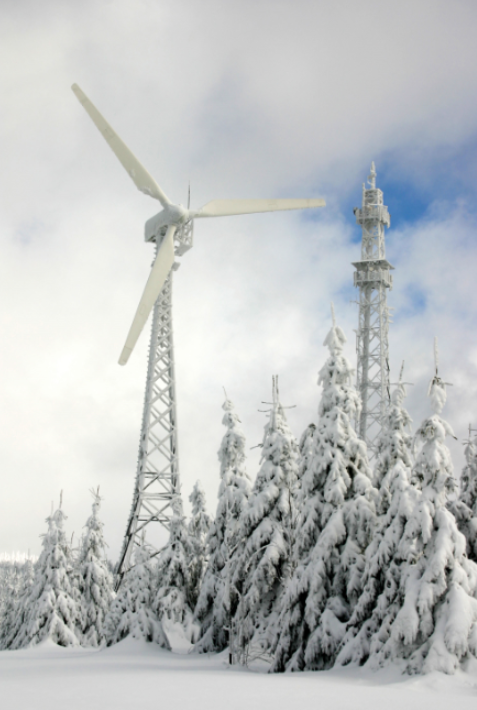Control system to optimize cold climate wind turbine performance
A method for mitigating wind turbine performance degradation caused by ice formation.

Applications
- Wind turbines
Key Benefits & Differentiators
- Practical & cost effective: required equipment can be retrofitted to existing turbines; no design changes required for new installations
- Reduces maintenance costs: no need for long durations of stoppage and deicing procedures
- Highly durable: no deteriorating coating or increased risk of lightning
- No additional energy consumption often required in conventional ice mitigation steps
- Uninterrupted operation and longer lifetime for wind turbines in cold regions
- Scalable
Overview
In cold climate regions, wind turbine icing represents the most significant threat to the integrity of wind turbines. Ice formation on turbine blades and irregular shedding during wind turbine operation lead to load imbalance and excessive, unpredictable turbine vibration. Consequently, wind turbines may shut off for days or even months, resulting in severe power loss. In addition, the shedding of large chunks of ice pose public safety issues. Currently available deicing and management techniques are inefficient, impractical, and expensive. The shortcoming of these techniques are:
- Electro-thermal or hot air: significant energy consumption, high operation & maintenance costs, difficult to be retrofitted to existing turbines
- Coatings: low durability and lifetime, inefficient, high cost
- Plasma: unproven in field, increased lightning risk, on-blade implementation is difficult
- Microwave: unproven in field, on-blade implementation is difficult
Prof. Jiarong Hong research group at the University of Minnesota has developed an advanced control strategy for effectively mitigating performance degradation associated with wind turbines operating in cold climates to minimize or eliminate blade deicing requirements thereby lowering operating costs. This method offers a systematic control framework for wind turbine operation during the entire icing life cycle (pre-icing, operational-icing, stopped-icing and post-icing phases). Specifically, this method uses meteorological icing forecast and onboard sensor data to predict and prescribe various operational parameters to reduce ice formation rate and ice-induced aerodynamic penalties (such as reduced lift or increased drag). The prescribed changes take advantage of both active pitch control and operational stop to alleviate the negative consequences of icing.
Phase of Development
TRL: 5-7Researchers have demonstrated this technique with field measurements in a 2.5 MW turbine at the Eolos Wind Research Station and have characterized ice-induced effects on turbine operational condition, power production and structural response in the pre-icing, operational-icing, stopped-icing and post-icing phases of an icing event.
Desired Partnerships
This technology is now available for:- License
- Sponsored research
- Co-development
Please contact our office to share your business’ needs and learn more.
Related Technologies
Wind turbine icing loss forecasting software
Control system to optimize wind turbine farm efficiencies
Researchers
- Jiarong Hong, PhD Associate Professor, Mechanical Engineering
- Linyue Gao, PhD Postdoctoral Researcher, Saint Anthony Falls Laboratory
-
expand_more library_books References (1)
- Gao, Linyue, and Jiarong Hong , Wind turbine performance in natural icing environments: A field characterization
-
expand_more cloud_download Supporting documents (1)Product brochureControl system to optimize cold climate wind turbine performance.pdf